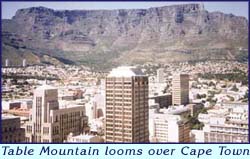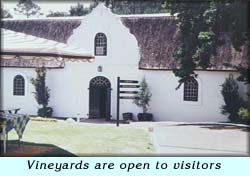
Forgetting fears, sipping reds, whites
On my first morning in Cape Town, I walked
past a cafe where a notice at the door read "No Firearms". A
fashion boutique a few yards further on sported a window sign warning of
"Armed Response".
 Even
at that time in the morning, in the main shopping area, I sensed fear in
the streets. So when I saw a store called 'The Protection Shop', I went
in. It was next to one selling guns and bullet-proof vests. Even
at that time in the morning, in the main shopping area, I sensed fear in
the streets. So when I saw a store called 'The Protection Shop', I went
in. It was next to one selling guns and bullet-proof vests.
I asked the storekeeper, who looked like an ex-commando, if the streets
of Cape Town were really as dangerous as they seemed. His response was
to hold up something that looked like a pen torch. Press the top and it
squirts liquid red pepper into the eyes of an assailant. He advised me
to buy it, just in case.
For someone used to the blanket of security that swaddles Colombo, the
idea of needing a weapon of personal protection to avoid being mugged,
was disturbing. Cape Town is scenically stunning. The sight of majestic
Table Mountain as a backdrop to the city, seems as welcoming today as it
did to the first European settlers of 1652.
Before the Dutch East India Company (VOC) established a 17th-Century
victualling station on Table Bay's pristine shore, the Cape Flats were
hunted for game by the Khoi-Khoi and the San bushmen. With colonisation
the Cape of Good Hope established such a strong tradition of hospitality,
that weary explorers and sailors regarded it fondly as "The Tavern
of the Seas".
Cape Town's looming crags are still a welcome sight, but the publicity
brochures that describe the city as "vibrant and friendly" need
to be read with a pinch of salt. Friendly most people may be but the city
isn't. Step out of your hotel after 6pm and you are asking for trouble.
Rudely-whistling lads lurk at street corners pretending to direct traffic;
you feel they are waiting to pounce. Even residents don't dawdle: one wineshop
assistant told me he had been mugged twice in the previous month while
on his way home from work.
Fortunately there is somewhere else in the city for those determined
to enjoy Cape Town: the Victoria and Alfred Waterfront. It dates back to
1860 when Prince Alfred, Queen Victoria's second son, tipped the first
rock for construction on Cape Town's original breakwater. When Alfred Basin
couldn't handle the increased volume of cargo brought with the advent of
steamships, the Victoria Basin was added. A company was set up in 1988
to develop this historic harbour, with a combination of tourism and commerce
complementing the port's working operations.
Now the waterfront has become the fashionable place to party. There
are seven hotels connected to miles of shopping malls where people roam
freely all evening.
The Victoria Wharf Shopping Centre features over 40 restaurants, coffee
shops and fast food outlets, together with 190 specialty shops and kiosks.
It has the longest trading hours in South Africa, from 9 a.m. to 9 p.m.
every day. For visitors, the waterfront has rescued the city from hell.
For a taste of Africa, instead of the fast food outlets of the malls,
in the city suburb of Observatory there is the Africa Cafe. The fixed menu
(at a cost of the equivalent of Rs. 810) includes 16 different dishes served
to the table in imitation of a traditional "Communal Feast".
There are no courses, every dish comes hot from the kitchen and is eaten
in any order. A traditional Xhosa pot bread called Umbako goes well with
a papaya and sweet red pepper relish from Senegal, and with East African
spinach in a sauce of groundnut, coconut milk and fresh chilli.
 Everyone
who visits Africa goes on safari. The countryside around Cape Town is famous,
not for game but for vineyards. Some of the finest wines in the world are
produced within 30 minutes drive of the city centre. A safari to the 29
vineyards around the town of Stellenbosch is a chance to taste them for
nothing. Everyone
who visits Africa goes on safari. The countryside around Cape Town is famous,
not for game but for vineyards. Some of the finest wines in the world are
produced within 30 minutes drive of the city centre. A safari to the 29
vineyards around the town of Stellenbosch is a chance to taste them for
nothing.
When Simon van der Stel took command of the Castle of Good Hope in 1679,
the European settlement was still confined to the slopes of Table Mountain.
During his first inspection of the cattle outpost of the VOC, der Stel
camped at Wildebosch. He liked it so much, that with the arrogance of the
colonist, he named it Stellenbosch (Stel's forest). He established a colony
of free farmers who grew vegetables, fruit and grapes. Stellenbosch thus
became, in 1687, the first European settlement in the interior of Southern
Africa.
The region's cool climate and fertile soils, combined with the planting
of the convivial varieties of grapes, have over 300 years produced wines
that are a challenge to the best.
At each of the 29 estates, there are tasting rooms where visitors can
sample these superb wines without having to buy any. Some, like Morgenhof,
serve lunch under the shade of venerable oak trees. In the sight of vine-clad
hills, I sipped glasses of the estate's renowned dry whites and soft reds.
With bottles of good quality wine selling for less than the equivalent
of Rs. 400, it was easy to forget the unsettling feeling of fear that stalked
the city. Cape Town, after all, was a pleasant port of call, and I never
did have to use the red pepper spray.
|







